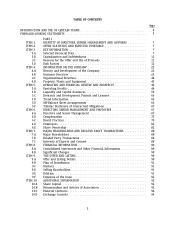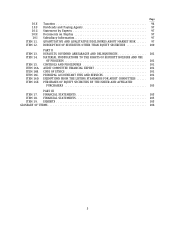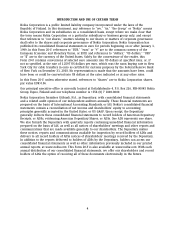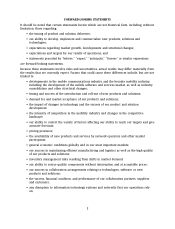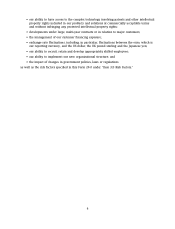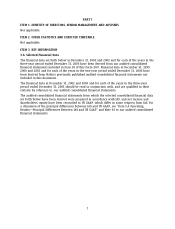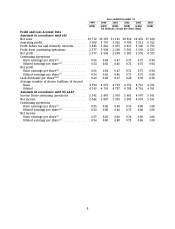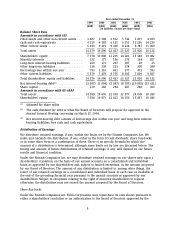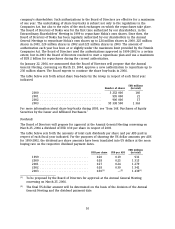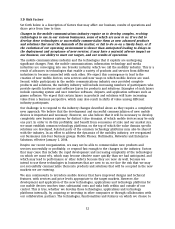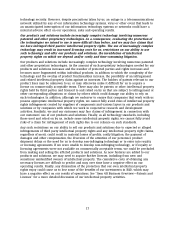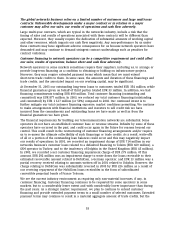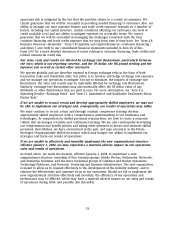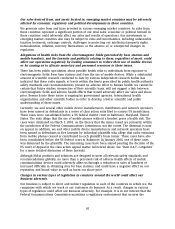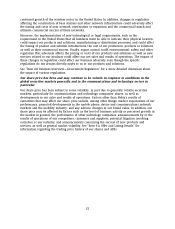Nokia 2003 Annual Report Download - page 13
Download and view the complete annual report
Please find page 13 of the 2003 Nokia annual report below. You can navigate through the pages in the report by either clicking on the pages listed below, or by using the keyword search tool below to find specific information within the annual report.3.D Risk Factors
Set forth below is a description of factors that may affect our business, results of operations and
share price from time to time.
Changes in the mobile communications industry require us to develop complex, evolving
technologies to use in our various businesses, some of which are new to us. If we fail to
develop these technologies or successfully commercialize them as new advanced products
and solutions that meet the demands of the market, or fail to do so on a timely basis, or if
the evolution of our operating environment is slower than anticipated leading to delays in
the deployment and acceptance of new services, it may have a material adverse impact on
our business, our ability to meet our targets, and our results of operations.
The mobile communications industry and the technologies that it exploits are undergoing
significant changes. First, the mobile communications, information technology and media
industries are converging into one broader industry, which we call the mobility industry. This is a
result of advances in technologies that enable a variety of products and services from different
industries to become connected with each other. We expect this convergence to lead to the
creation of new mobile devices, new services and new ways in which mobile devices are used.
Second, while participants in the mobile communications industry once provided complete
products and solutions, the mobility industry will include increasing numbers of participants who
provide specific hardware and software layers for products and solutions. Examples of such layers
include operating system and user interface software, chipsets, and application software such as
games software. We expect that certain layers in products and solutions will have increasing
value from a business perspective, which may also result in shifts of value among different
industry participants.
Our challenge is to respond to the industry changes described above as they require a completely
new approach. We believe that the development and successful commercializion of new mobile
devices is important and necessary. However, we also believe that it will be necessary to develop
completely new business systems for distinct value domains, of which mobile devices may be only
one part. In order to do this profitably, and benefit from economies of scale and our market size,
we must establish common technology platforms, on the top of which the value domain specific
solutions are developed. Selected parts of the common technology platforms may also be shared
with the industry. In an effort to address the dynamics of the mobility industry, we reorganized
our businesses into four business groups: Mobile Phones, Multimedia, Networks and Enterprise
Solutions, effective January 1, 2004.
Despite our recent reorganization, we may not be able to commercialize new products and
services successfully or profitably, or respond fast enough to the changes in the industry. Factors
that may cause this include the rapid development and increasing complexity of the technologies
on which we must rely, which may become obsolete more quickly than we had anticipated, and
which may lead to performance or other defects because they are new. As well, because we
intend to use these technologies in businesses that are new to us, we face the risk that we may
not successfully commercialize them into products and solutions that will be accepted in the new
markets we are entering.
We aim continuously to introduce mobile devices that have improved designs and technical
features, with services and price levels appropriate to the target markets. However, the
development and application of the new technologies, applications and technology platforms for
our mobile devices involves time, substantial costs and risks both within and outside of our
control. This is true, whether we develop those technologies, applications and technology
platforms internally, by acquiring or investing in other companies or through collaboration with
our collaboration partners. The technologies, functionalities and features on which we choose to
12


